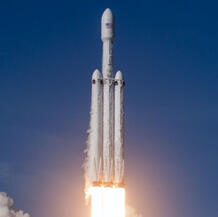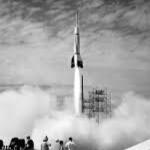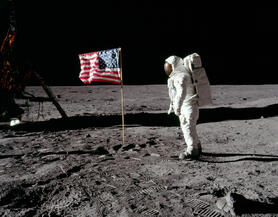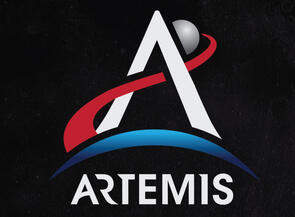
KALLISTO: The Blog
Welcome to our blog! Check out our posts below! 💫
Blog Articles
September blog posts
Rock-IT'S Time to Discuss!
Steady on the surface level; we stand gazing at the vast universe million yards away from our figure. The stars twinkle brightly with the benevolent guise of the moon, similar to our goals. When our ambitions seem too insurmountable, we can feel the world's weight fall upon our shoulders. However, we should not succumb to the overwhelming pressure; instead, take the leap of faith for the dream we strive to grasp. As such, we ponder back on the history and timeline of memorable rocket launches, which altered the Space Age!
Bumper Project
First on the list — The Bumper Project that led to a moon port’s birth, which aimed to test aerodynamic data at hypersonic birth speeds! The first all-up flight was on September 30, 1948, wherein the engine exploded upon ignition. The next second, third, and fourth trials failed, but thankfully, the fifth flight succeeded on February 24, 1949, where the WAC reached a record altitude of 393 km! Unfortunately, the sixth trail failed but with a high-altitude, and then the last two bumpers were fired horizontally to meet the original objective. On July 29, 1950**, The Army selected to launch two Bumpers at Cape Canaveral. The WAC accelerated to 5260 kph! Despite the numerous failed attempts wherein, the first flight failed - the crew pursued their goal, and, on the final endeavor, they accomplished their goal!
Gleen Orbits the Earth
On February 20, 1962, NASA launched one of its most prominent flights that altered American history! What makes it essential? The purpose of the flight is to send a man to orbit Earth. Who was the pilot of this memorable flight? The one and only John Gleen, a national hero and symbol of American ambition. He got abroad the Mercury capsule Friendship 7 and became the third American in space and the first to orbit Earth! Within 4 hours and 56 minutes, John Gleen circled the globe three times, achieving an estimated momentum of 17,000 miles per hour. The event concluded with a landing in the Atlantic Ocean. Afterwards, John Gleen explained that operating the flight was no easy feat due to the end of his first orbit, a jet clogged, prompting him to abandon the automatic control system and opt to control the system manually. With that, the revolutionary launch started many others to be reach for the stars and further improve rockets' engineering!
Apollo 11
"One small step for a man, one giant leap for mankind." At 10:56 P.M. EDT, July 20, 1969, American astronaut Neil Armstrong set foot unto the moon — making him the first man to step on the moon. Following him was his crewmates Edwin "Buzz" Aldrin, while Michael Collins, the third astronaut, stayed in the Apollo capsule. The Apollo 11 mission was the first of the six Moon landings to perform a crewed lunar landing and return to Earth with other goals. The lunar module's objectives were scientific exploration, deployment of a television camera to transmit signals to Earth - which proved successful since an estimated 650 million people watched the televised image and heard Armstrong's voice. In a post-flight press conference, Amstrong states the launch is "a beginning of a new age" — indeed, the historic feat inspired many people to persevere for their dreams. In contrast, many others joined in evolving rocket science further to pave a brighter path to space exploration!
1st Private Crewed Flight Launch
Recently, on May 30, 2020, at 3:22 P.M., the private company SpaceX, in partnership with NASA, launched a two-person crewed commercially built and operated spacecraft entitled Dragon 2! The SpaceX Crew consisted of NASA astronauts Robert Behnken and Douglas Hurley. The project's very culmination proves the hard work put upon to ensure a stable and organized commercial rocket — this demonstrates that rocket technology will continue to advance as years pass exceptionally alongside humans who have never-ending curiosity and initiative!
Artemis: Women on the moon !
NASA announced Artemis, a program that envisions to perform a moon landing for the first woman and next man in 2024, utilizing recent technologies to expand more of the lunar surface than ever before! Furthermore, NASA states that they will collaborate with commercial and international partners to ensure sustainable exploration by the end of the year. They will gather insights and notes on Project Artemis to prepare for the next giant leap humanity’s— sending astronauts to Mars. Future objectives like this genuinely establish that humankind continuously evolves day-by-day to explore, grasp their ambitions, and invent new ideas to satisfy our curiosity.
What's in the future of space exploration?
The history of rocket launches truly evolved these past years and continues to develop as we speak — from multiple rocket test flights to planning for the launch going to Mars. It is evident that humanity's passion for space exploration will never falter — coming from the fact that through all these projects, they encountered technical difficulties, but chose to conquer those hurdles through launching themselves to greater heights. The future of space exploration is vast as the universe, with many individuals aiming to reach to infinity and beyond!
References
Dunbar, B. (2020). NASA Launch Schedule | Rocket Launches. National Aeronautics and Space Administration. Retrieved from https://www.nasa.gov/launchschedule/
Dunbar, B. (2020). Nasa Artemis. National Aeronautics and Space Administration. Retrieved from https://www.nasa.gov/specials/artemis/
Rocket Launch List. Space Coast Launches. Retrieved from https://spacecoastlaunches.com/launch-list/
(2011) Brief History of Rockets - Timeline. The Science Learning Hub - Pokapū Akoranga Pūtaiao. University of Waikato te Whare Wananga o Waikato, New Zealand. Retrieved from https://www.sciencelearn.org.nz/resources/1868-brief-history-of-rockets-timeline
A picture History of Rockets. National Aeronautics and Space Administration. Retrieved from https://www.nasa.gov/pdf/153410mainRocketsHistory.pdf
(2019). July 20, 1969: One Giant Leap For Mankind. National Aeronautics and Space Administration. Retrieved from https://www.nasa.gov/missionpages/apollo/apollo11.html_
Potter, S. (2020). Nasa Astronauts Launch from America in the Historic Test Flight of SpaceX Crew Dragon. National Aeronautics and Space Administration. Retrieved from https://www.nasa.gov/press-release/nasa-astronauts-launch-from-america-in-historic-test-flight-of-spacex-crew-dragon
How do rocket launches work?
What do you know about Newton’s three laws of motion? Sound familiar? These laws lay the foundation for classical mechanics or physics dealing with the motion of large objects here on earth. So let’s dig into a little bit of classical or Newtonian mechanics before we lift off!
Newton's 1st Law of Motion
The First Law tells us that objects at rest will stay at rest, and objects in motion will remain in motion unless acted upon by an unbalanced force.
Now, imagine holding a ball on the palm of your hand. Make sure you hold it steady so the ball stays still! Right now, your ball is being acted upon by forces. The force of gravity is pulling the ball down while the normal force from your hand is pushing it up. Since the ball is at rest, we can conclude that the forces acting upon it are balanced. They would only be unbalanced if you let the ball fall down or if gravity ceased to exist!
The same thing applies to rocket launches because, while a rocket is on its launchpad, the forces acting upon it are balanced, and therefore, the rocket is at rest. So how do we bring rockets out into space? Let’s jump right into the third law!
Newton's 3rd Law of Motion
The Third Law states that for every action, there is always an equal and opposite reaction. Don’t you find it bizarre that swimmers would push off the wall with their feet to move forward? Well, it’s actually based on this simple concept! The wall exerts the same amount of force to the swimmer as a reaction to their pushing off the wall.
Rockets use engines that turn fuel into hot gas, and it is this gas that pushes the rocket off the launchpad by applying an upward force called “thrust.” How might we propel rockets into space? That’s a good question. While on Earth, the surrounding air would only slow the rocket down as a from of air resistance–also called drag. There is no air in space, allowing the rocket to move quickly without having to worry so much about drag or releasing as much gas as it would need to on Earth. Although, you can just imagine how strong the thrust force would have to be to move an object as massive as a rocket out into space.
Newton's 2nd Law of Motion
This is where the Second Law comes in. It’s a bit difficult to comprehend the second law, but it’s essentially just a mathematical equation. It simply states that force is equal to mass multiplied by acceleration. Let’s rephrase that a little bit by giving an example. It is pretty easy to push a chair, isn’t it? But we can’t really say the same thing for cars and other vehicles! If you observe closely, it takes more effort to move larger objects than smaller objects. That is basically what the Second Law means. The greater an object's mass, the greater the force needed to move it!
Rocket staging is a technique that fully maximizes the Second Law! A typical rocket can be divided into sections, or stages, all of which fire engines in a particular order then detach. Eventually, certain parts like the early-stage rocket engines and fuel tanks just become excess baggage once used. As the unnecessary weight is removed, the overall mass of the rocket rocket’s decreases, and by Newton’s Second Law, the amount of force needed to move the rocket decreases too! This allows the rocket to move faster and faster as it exits into space.
Rocket Staging
There are two main types of rocket staging. Serial staging is the first type which involves stacking rocket stages on top of each other. Typical rockets have two stages but can have more. The Saturn V, which was used for the Apollo missions, was a three-stage rocket.
In serial staging, the first stage is usually the largest and is mainly used to get the rocket out of the Earth’s atmosphere. The engine will continue to fire until it empties its fuel. Afterward, it will detach itself from the rocket and fall to the ground. Rocket launches are done near the equator to maximize Earth’s velocity, which is highest at this point.
The second stage needs less power as the rocket is already traveling at a high velocity. Its overall mass would have significantly decreased after the detachment of the first stage. This is where the rocket is put into its final orbit to release its payload, or whatever it is carrying–may it be a satellite or a spacecraft. Afterward, it will detach itself as well. For rockets with additional stages, the process will simply repeat until the rocket is finally in space!
The second type is Parallel staging, wherein several small first stages, strapped to a central rocket, are ignited at launch and discarded when fully-used. The central rocket continues to burn until the payload is brought to orbit.
In earlier rocket launches, the discarded parts were left to burn as they entered the Earth’s atmosphere. Eventually, guiding technologies were invented to make the parts retrievable by letting them land in bodies of water.
Well, that’s about it!
To summarize, 1) Rockets need an unbalanced force to launch into space, 2) An action, by the form of thrust force, must be done for the rocket to react and start moving, and 3) By gradually discarding its parts through the process, rockets can lessen their mass and move quickly with a higher velocity.
In terms of rocket science, reading this article has merely gotten an engine to ignite the fuel, but we hope it’s given you some sense of how rockets get launched! While rocket launches have evolved so much through the years, there’s undeniably still so much to explore! Who knows? Maybe someday, we’d even get to see you launch your own!
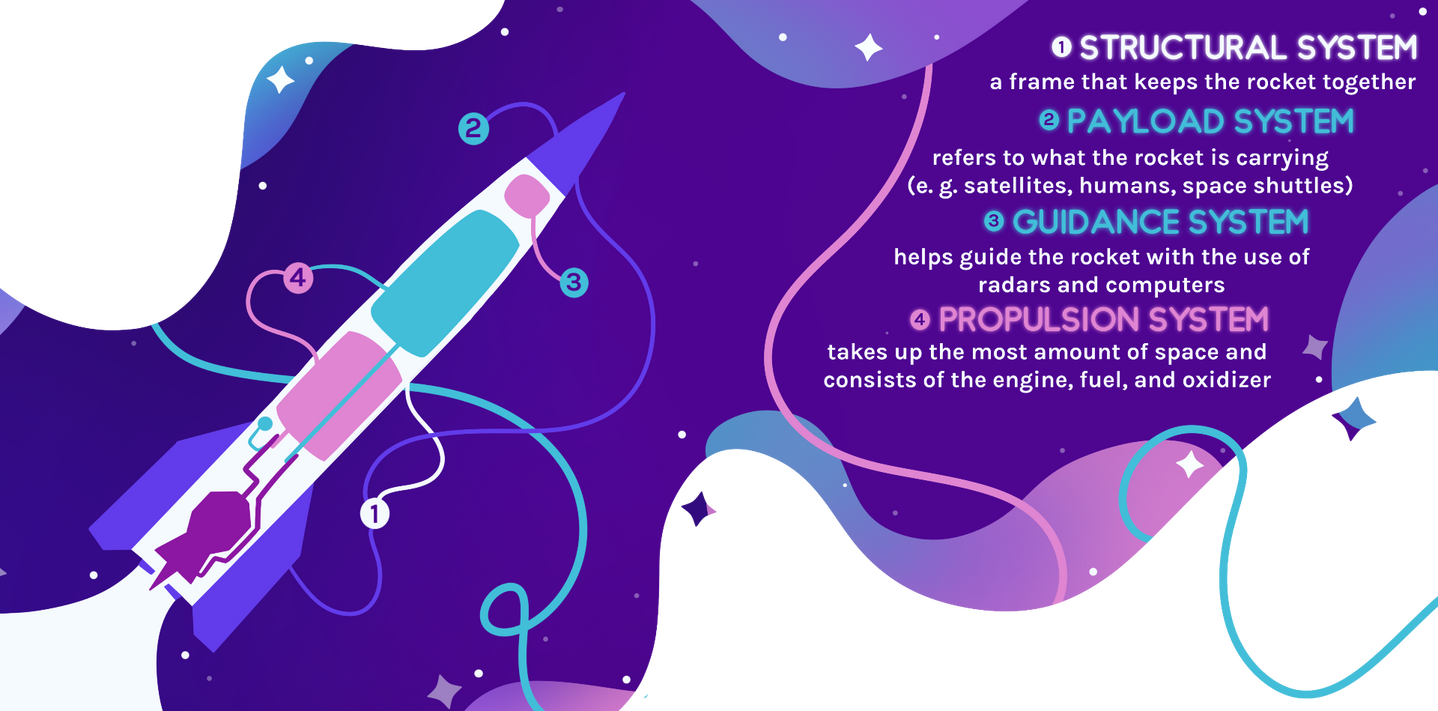
References
Benson, T. (2015, June 12). Rocket parts. National Aeronautics and Space Administration. https://www.grc.nasa.gov/www/k-12/rocket/rockpart.html#:~:text=There%20are%20four%20major%20systems,the%20fuselage%20of%20an%20airplane.
Benson, T. (2014, June 12). Rocket principles. National Aeronautics and Space Administration. https://www.grc.nasa.gov/www/k-12/rocket/TRCRocket/rocket_principles.html
Dunbar, B. (2017, August 7). What was the Saturn V. National Aeronautics and Space Administration.
https://www.nasa.gov/audience/forstudents/5-8/features/nasa-knows/what-was-the-saturn-v-58.html
Lopez, D. R. (2018, November 1). Rocket Staging. National Aeronautics and Space Administration .https://www.grc.nasa.gov/www/k-12/rocket/rktstage.html#:~:text=There%20are%20two%20types%20of,until%20its%20propellants%20are%20exhausted.
Greshko, M. (2019, January 4). Rockets and rocket launches, explained. National Geographic. https://www.nationalgeographic.com/science/space/reference/rockets-and-rocket-launches-explained/
Teitel, A. S. (2018, February 17). The how and why of rockets’ staging. Discover Magazine. https://www.discovermagazine.com/the-sciences/the-how-and-why-of-rockets-staging
Timm, P. (2017, April 24). Stages of a rocket launch. Sciencing. https://sciencing.com/stages-rocket-launch-6922973.html
Woodford, C. (2019, November 3). Space rockets. Explain That Stuff. https://www.explainthatstuff.com/spacerockets.html

To Infinity and Beyond!
You are one of over seven BILLION people who lives in a big blue marble that we call our home: Earth. However, our planet occupies just a tiny fraction of the Solar System, governed by the Sun, our only astronomical star, and one of the many more celestial bodies - which our galaxy, the Milky Way, contains a few a handful. As such, the universe is vast, filled with astral entities, anxiously waiting to be found by us.
With all the eternal bounds to ponder on, it is natural to feel insignificant. After all, there is so much to explore and discover. For this purpose, Kallisto presents you with the wonders of what the universe has in store for you! A preview that lets you have a taste of what lies to infinity and beyond our reach. Scaling from the celestial bodies found in our very own Solar System, to our local group of galaxies, even what exceeds the large expanse - there is always something to learn and explore.
What’s Out There in our Solar System?
JUPITER'S MOONS
As of this moment, Jupiter has 79 moons. Yes, seventy-nine. Nonetheless, out of all those 79 moons, there are four exceptional ones, called the Galilean Moons. They were all discovered by the astronomer, Galileo Galilei in 1610, hence the nickname, “Galilean Moons.”
GANYMEDE
First, we have Ganymede, the biggest out of the Galilean Moons. It spans 5,268 kilometers in diameter, making it more massive than the planet Mercury. Its surface composes of rocky material and ice. Furthermore, it sports broad and bright ridges and grooves that seem to cut through the darker ones on its surface. The division is the result of two types of terrain on Ganymede’s surface. The bright areas are a younger terrain, while the darker areas are older. Aside from that, this moon carries extensive, but few craters with it. Moreover, a unique trait about this moon is that it is the only known moon to host a magnetic field.
Aligned with that, it enables the moon to manifest auroras, similar to ones on Earth. To add, scientists believe that Ganymede may contain liquid water under its surface. It also has a fragile atmosphere made out of oxygen, but sadly, it’s too thin to support life.
CALLISTO
Meanwhile, we have the farthest Galilean Moon from Jupiter, Callisto. Sound familiar? (That’s us!) It is far enough that it doesn’t gravitationally interact with the other three moons. Aside from that, it’s also a little smaller than Ganymede and the planet Mercury, as it is only 4820 kilometers in diameter. Similar to Ganymede, Callisto has a rocky and icy surface.
Nevertheless, unlike Ganymede, it has numerous craters. Callisto litter the surface, classified as the most heavily cratered object in the Solar System. Since it has copious amounts, they theorized that Callisto has little to no geologic activity to erode the craters away, resulting in its surface to be one of the oldest in the Solar System, estimated at around 4 billion years old. Some of these craters cap with ice, which illustrates why Callisto has bright spots along its exterior. In its interior, Callisto may host a salty underground ocean 250 kilometers underneath - a salty ocean implies that the moon may potentially host life.
IO
Last but not least is Io. Io is the closest Galilean moon to Jupiter. Aside from that, it is only 3643 kilometers in diameter, making it just a bit larger than Earth's moon. Its predominantly yellow color comes from the sulfur and silicate rock on its surface. However, what sets Io apart from the others is the presence of volcanoes. Io is the most volcanic object in the Solar System, as over 400 volcanoes are active on its surface. These volcanoes are why Io has no impact craters since molten lava from them can easily cover them up. Knowing all that, why is Io so volcanically active? This surprising amount of activity is due to Jupiter's gravitational pulls and two other Galilean moons (Europa and Ganymede). These bodies pull on either side of Io, generating enormous heat and energy within it. Sadly, because of the tremendous amount of heat and volcanic activity in Io, it has no water, unlike the other moons.
The Sun
Despite being an object, we see and feel every day; there is countless more to be recognized about the Sun. As we all know, it is the most prominent object in the Solar System, taking up about 99.8% of the Solar System's mass. It has a 605,508 kilometers radius, making it big enough for one million Earths to fit inside. Unfortunately, we don't get to see our star's actual size due to it being around 150 million kilometers from us. The thing is, even though the Sun is unimaginably big, it is only classified as a yellow dwarf star, implying that the size of our Sun is pretty average compared to other stars out there.
The Sun has six regions: the Core, Radiative Zone, Convective Zone, Photosphere, Chromosphere, and Corona. First, we have the Sun's core, the hottest part of the Sun. It sits at about 15 million degrees Celsius, which is hot enough for thermonuclear fusion. Thermonuclear fusion is a process every star goes through, where atomic nuclei fuse into heavier elements. Thus, it releases enormous amounts of energy, and it produces all heat and light that the Sun emits.
Further out from the core is the Radiative Zone. Through radiation, all energy from the center goes to this zone. Next, we have the Convective Zone. This zone is much more relaxed than the core, as it's around 2.5 million degrees Celsius instead. Ionized atoms, also known as Plasma, move up from this zone as well. Afterward, we have the Photosphere, also known as the Sun's surface. The Photosphere is now even colder, at 10,000 degrees Celsius. However, it's still hot enough to boil graphite and diamonds. It is 500 kilometers thick, and it consists of gases, not solids. Most of the radiation here escape outwards, and we see that radiation as sunlight. Next, we move on to the regions located in the Sun's atmosphere. The Chromosphere contains light that is usually too weak to be seen. During Solar eclipses, though, it is present as a red rim around the Sun. Lastly, we have Corona. (No, not COVID-19!) It can only be seen during solar eclipses, looking like a white crown shaped like flower petals. Strangely enough, the Sun's atmosphere heats the higher you go, reaching temperatures as high as 2 million degrees Celsius. However, this situation is considered a scientific mystery.
What’s Out There in our Galaxy?
Sagittarius A* Black Hole
Black holes have a gravitational field so strong that even light cannot escape it, resulting in a hole darker than the night. There are two kinds of black holes: the baby black holes and the giant or supermassive black holes. Supermassive black holes are theorized to be in the center of every galaxy. These factors considered Sagittarius A, a black hole in the center of our universe, a supermassive one.
Knowing all this, why is a black hole's gravitational field unbelievably strong? Well, the reason for this all boils down to how it was formed in the first place. When a star dies, its gravity overtakes it, and the star collapses. Massive stars (more gigantic than our Sun) end up going supernova. As this happens, the star's surface collapses into itself, creating a black hole. A black hole is usually several times smaller than its parent star, but it still retains the star's mass. Since a star's mass has crammed into a very, very small area, the gravitational pull of a black hole is powerful. So strong that even light cannot escape its influence. Fortunately for us, less than 1% of material in Sagittarius A's effect reaches its event horizon or the point of no return. Most material ejects from the black hole, so our galaxy has a meager chance of being devoured.
UY Scuti
Discovered in 1860 by German astronomers, UY Scuti is the biggest known star in the Milky Way galaxy. It is 5,219 light-years away, and it’s located in the constellation of Scutum. Sadly, we don’t quickly realize how big this star is due to its distance from us. UY Scuti is a Red Hypergiant with a radius of 1.1883 BILLION kilometers, which is over 1700 times bigger than the Sun’s. If this massive star were to replace the Sun in our Solar System, its surface would reach Jupiter and Saturn’s orbits, devouring Earth in the process. Aside from being way bigger than the Sun, it’s also way brighter. UY Scuti has an absolute magnitude of -6.2, making it 340,000 times more luminous than our Sun. It can change its brightness, though, and from Earth, it can be viewed as a pulsating star. Aside from that, its surface temperature is about 3,365 Kelvin, or 3091 degrees Celsius, making it a lot cooler than the Sun’s surface. Even so, it still has a very similar composition to the Sun’s (Hydrogen, Helium, and heavier elements).
But why is UY Scuti so big? Was it always like this? In actuality, no. UY Scuti wasn’t this big before. Before turning into a Red Hypergiant, UY Scuti must have been a Blue Main-sequence star. Blue Main-sequence stars are much smaller than Red Hypergiants but are still more massive than our Sun. Like Blue main-sequence stars, average stars maintain a balance between two opposing forces: gravity and internal heat. This balance keeps the size of the star. Inside its core, pressures and temperatures are hot enough to fuse the nuclei of atomic elements. This fusion releases a lot of energy and creates heavier elements. For example, Hydrogen atoms will fuse into Helium atoms. Helium atoms will fuse into Carbon atoms, etc. Heavier elements like Carbon take higher temperatures and pressures to merge, but since UY Scuti has a high enough mass, it can fuse elements up until Iron. However, the problem starts when a star runs out of Hydrogen atoms to fuse. When this happens, Helium fusion begins, disrupting the balance between its two opposing forces. Because of this, its surface swells up into a Red Supergiant or even Hypergiant. These events result in UY Scuti’s present appearance. Since UY Scuti is believed to have started fusing Helium, this makes it an aging star that will eventually go supernova.
What’s Out There in our Local Galaxy Group?
Andromeda Galaxy
Andromeda Galaxy, also known as Messier 31, is our nearest galactic neighbor despite being about 2.5 million light-years away. It’s also a spiral galaxy, much like ours, containing around a trillion stars. Andromeda Galaxy’s central area is full of yellowish stars. It also has a ring of dust present in its center, which may prove that the galaxy has had previous collisions. The universe also has a blue ring full of clusters of young (and blue) stars. That is also the region where new stars form. Since Andromeda Galaxy is the closest galaxy to us, it can be observed by the naked eye. This galaxy is best observed in a dark area in November.
The real exciting thing about this galaxy is… it’s heading towards us. That’s right - the Andromeda galaxy is approaching the Milky way at 112 kilometers per second. That may be fast for us, but on the scale of the universe, it’s not at all since the collision won’t happen until approximately 4 billion years later. It will take another 2 billion years after that for it to fully merge with the Milky Way, forming the Milkdromeda elliptical galaxy. By that time, though, the Sun will have already expanded into a Red Giant, consuming all life from Earth, so humans probably won’t be able to see the collision from our home planet.
Tarantula Nebula
The Tarantula Nebula, also known as 30 Doradus, is the biggest known nebula. It is the brightest and most active star-forming region that spans over a thousand light-years across. It's located in Dorado's constellation, otherwise known as The Dolphinfish, a part of the Large Magellanic Cloud, a dwarf galaxy. The Tarantula Nebula contains many star clusters such as NGC 2070, Hodge 301, NGC 2060, and NGC 2100. Many of those clusters contain stars that have gone supernova. It also includes a supernova called 1987A, which burned with the energy of 100 million Suns for months.
What’s out of our reach? Out there?
Bootes Void
Also known as “The Great Nothing,” the Bootes Void is one of the largest voids in the observable universe. It’s located around the “Ploughman” constellation, and it’s a rough sphere of around 280 million light-years in diameter. Aside from that, the Void is a whopping 700 million light-years from Earth.
The Bootes Void only contains 60 galaxies. Compared to the Virgo Supercluster with around 2000 galaxies, the Void is empty compared to the rest of the universe. It’s so dark and open that, according to Greg Aldering, if the Milky Way galaxy was situated in its center, we wouldn’t have known of the existence of other galaxies until the 1960s.
The Great Attractor of the Laniakea Supercluster
The Laniakea Supercluster is an enormous cluster of galaxies spanning 500 million light-years in diameter. Our Milky Way galaxy, our local galaxies, and 100,000 other galaxies are a part of this giant supercluster. Keep in mind, though, galaxies here are not distributed evenly. Through gravity, they tend to group to form small clusters (like our local group), connecting to other galaxy clusters through gravity. This creates an even bigger cluster of galaxies until a supercluster, much like Laniakea, is formed.
Knowing all this, what exactly is the Great Attractor? The Great Attractor is a gravitational anomaly located in the Laniakea Supercluster that pulls all of its galaxies. It is around 150 million light-years away, yet our galaxy is approaching this anomaly at approximately 2,160,000 kilometers per hour. To put this into perspective, if the Earth were to revolve around the Sun that quickly, one year would be equal to 18 days only. Unfortunately, a part of the Great attractor is hidden behind the Milky Way’s Zone of Avoidance, an area of the sky jam-packed with so much dust and gas from the Milky Way that it covers everything behind it. Because of this, the mysterious force behind the Great Attractor cannot be identified.
What’s… over here?
Indeed, the universe filled with so much wonder and mystery from every nook and cranny. Furthermore, there is so much more that needs to be studied and explored. Through the emergence of our own Philippine Space Agency, our organization, aka Kallisto, and our various projects, we hope that you may learn of the wonder of the universe and everything beyond it! (Call us a black hole, because we have all the info you never knew you wanted to know concentrated in one place!) With projects such as our monthly newsletter and our movie and song recommendations, may we spark a curiosity within you to learn more? The interest to get up and explore what lies in the skies, and to chase the stars.
References
Brown, D. (2015). What’s the biggest star in the Universe?. Retrieved on September 12,
2020, from https://phys.org/news/2015-12-biggest-star-universe.html
CrashCourse. (2015). High mass stars: Crash course Astronomy #31 [Video]. Retrieved
September 12, 2020, from https://www.youtube.com/watch?v=PWx9DurgPn8
CrashCourse. (2015). Jupiter’s Moons: Crash Course Astronomy #17 [Video]. Retrieved
September 10, 2020, from https://www.youtube.com/watch?v=HaFaf7vbgpE&t=191s
Dvorsky, G. (2012, June 6). Behold the Bootes void, the spookiest place in the cosmos. Retrieved
September 12, 2020, from
https://io9.gizmodo.com/behold-the-bootes-void-the-spookiest-place-in-the-cosm-5923493
EarthSky. (2014, September 3). Astronomers define boundaries of our home supercluster and
name it Laniakea. Retrieved on September 12, 2020, from https://earthsky.org/space/laniakea-is-the-new-name-for-our-home-supercluster-of-galaxies
ESO. (2018, May 30). Tarantula Nebula : A crowded neighborhood. Retrieved on September 12,
2020, from
https://phys.org/news/2018-05-tarantula-nebula-crowded-neighborhood.html
Kettley, S. (2020, July 15). Space mystery: What is this object stretching 1.4 billion
light-years across space?. Retrieved September 12, 2020, from
https://www.express.co.uk/news/science/1309744/Space-mystery-astronomers-detect-South-Pole-Wall-filament
Mahoney, T. (2020, May 7). The Great Attractor explained, Retrieved on September 12, 2020,
from https://medium.com/predict/the-great-attractor-explained-bea88869f852
NASA. (2019). Black Holes. Retrieved on September 12, 2020, from
https://science.nasa.gov/astrophysics/focus-areas/black-holes
NASA. (2019). Callisto. Retrieved September 12, 2020, from
https://solarsystem.nasa.gov/moons/jupiter-moons/callisto/in-depth/
NASA. (2019). Enceladus. Retrieved September 12, 2020, from
https://solarsystem.nasa.gov/moons/saturn-moons/enceladus/in-depth/
NASA. (2019). Europa. Retrieved September 12, 2020, from
https://solarsystem.nasa.gov/moons/jupiter-moons/europa/in-depth/
NASA. (2019). Ganymede. Retrieved September 10, 2020, from
https://solarsystem.nasa.gov/moons/jupiter-moons/ganymede/in-depth/
NASA. (2019). Io. Retrieved September 12, 2020, from
https://solarsystem.nasa.gov/moons/jupiter-moons/io/in-depth/
NASA. (2019, October 23). Messier 31 (The Andromeda Galaxy). Retrieved on September 12,
2020, from https://www.nasa.gov/feature/goddard/2017/messier-31-the-andromeda-galaxy
NASA. (2019). Our Sun. Retrieved on September 12, 2020, from
https://solarsystem.nasa.gov/solar-system/sun/in-depth/
NASA. (2017, August 29). Supermassive Black Hole Sagittarius A*. Retrieved on September 12,
2020, from
https://www.nasa.gov/missionpages/chandra/multimedia/black-hole-SagittariusA.html
NASA. (2020, January 28). Tarantula Nebula Spins Web of Mystery in Spitzer Image. Retrieved on
September 12, 2020, from
https://www.nasa.gov/feature/jpl/tarantula-nebula-spins-web-of-mystery-in-spitzer-image
NASA. (2019). Titan. Retrieved on September 12, 2020, from
https://solarsystem.nasa.gov/moons/saturn-moons/titan/in-depth/
Overbye, D. (2020, July 10). Beyond the Milky Way, a galactic wall. Retrieved on September
12, 2020, from https://www.nytimes.com/2020/07/10/science/astronomy-galaxies-attractor-universe.html
Sokol, J. (2016, October 18). Space is full of gigantic holes that are bigger than we expected.
Retrieved on September 12, 2020, from
https://www.newscientist.com/article/2109398-space-is-full-of-gigantic-holes-that-are-bigger-than-we-expected/
Redd, N. T. & Howell, E. (2019, March 11). The Andromeda Galaxy (M31): Locations, characteristics
& Images. Retrieved on September 12, 2020 from
https://www.space.com/15590-andromeda-galaxy-m31.html
UY Scuti facts. (2020). Retrieved on September 12, 2020, from
https://nineplanets.org/uy-scuti/
Image sources:
NASA/JPL. (2014). Europa’s stunning surface [Image]. Retrieved on September 19, 2020,
from https://solarsystem.nasa.gov/resources/204/europas-stunning-surface/?category=moons/jupiter-moonseuropa
NASA/JPL. (2019).
Ganymede [Image]. Retrieved on September 19, 2020, from
https://solarsystem.nasa.gov/moons/jupiter-moons/ganymede/in-depth/
NASA/JPL/DLR. (2001). Global Callisto in color [Image]. Retrieved on September 19, 2020,
from https://solarsystem.nasa.gov/resources/811/global-callisto-in-color/?category=moons/jupitermoonscallisto
NASA/JPL - Caltech. (2017). The galaxy next door [Image]. Retrieved on September 22, 2020,
from https://www.nasa.gov/missionpages/galex/pia15416.html
NASA/JPL - Caltech. (2020). Tarantula nebula Spitzer 2-color image [image]. Retrieved on
September 22, 2020, from
https://www.jpl.nasa.gov/spaceimages/details.php?id=PIA23646
NASA/JPL/University of Arizona. (1999). Global image of Io (true color) [Image]. Retrieved
on September 19, 2020, from https://solarsystem.nasa.gov/resources/808/global-image-of-io-true-color/?category=moons/jupiter-moons_io
NASA/SDO. (2017). Sun emits a solstice flare and CME [Image]. Retrieved on September 20,
2020, from https://solarsystem.nasa.gov/resources/386/sun-emits-a-solstice-flare-and-cme/
Title
Author
Editor
Blog info text + gallery for photos

